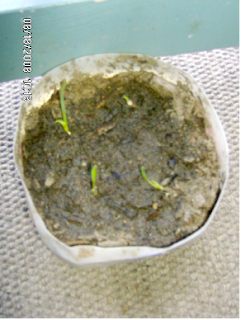



First up, my planters: I’ve had the worst sort of success with the plants I bought at Wal Mart and stuck in pretty planters on our balcony. I’m not sure what went wrong. I had tomatoes, cucumbers, and zucchini, all of which are practically fool proof. When I watered them, the leaves turned yellow. When I didn’t water them for a day, thinking they were getting too much water, they went limp. So I’ve presently got two scrawny tomatoes that haven’t accomplished anything, and dead vines. Nice, right?
Then, a number of weeks ago, I saw a blog post by someone who took ordinary bought from the store brown lentils and got them growing at home. I naturally thought, “I can do that!” It doesn’t hurt that our weather has suddenly turned very spring like, with reasonably warm days in the mid 80’s and cool nights. So I got an empty gallon milk jug, cut it in half, filled with dirt, and planted a handful of seeds. Three weeks later, most of the seeds have sprouted and are growing joyously. I’ve thinned them once and expect to have to do so again in a couple weeks when the late starters really get going.
About a week after the lentils, my jar of farmer’s market garlic cloves got inexplicably damp. By the time I noticed and dried the jar out, quite a number of cloves had sprouted pretty green shoots. Considering my lentils had just started sprouting, I decided to get out another milk jug and some more dirt and plant garlic. In addition to sprightly sprigs of lentils, I also have four gregarious garlic shoots. They haven’t grown much in height yet but the frail little shoots popping out two weeks ago have turned into sturdy dark green leaves. I can see more leaves developing underneath too.
Yesterday I started thinking about how much Ba’al and I enjoy lima beans. It just so happens I have a jar of lima beans in my cupboard. “If I can get store bought lentils to grow, I wonder if I can get store bought beans to do the same?” I thought. Out came another milk jug (I save them for use as storage containers), the last of my potting dirt, and the jar of lima beans. In about two weeks, we will know the success or failure of this latest experiment.
I’ve already devoted a considerable amount of thought to the issue of pollination, which may very well need to happen after the birds, bees, and butterflies have disappeared until spring. If these lentils and beans happen to be self-pollinating varieties, then I have nothing to worry about. They will take care of themselves regardless of where they are growing, indoors or out. If they need some external mechanism, I may find myself pollinating with a Q-tip or situating them in front of a briskly blowing fan. Needless to say, I am very much hoping either for self-pollination or for flowers to occur before fall truly sets in!
I am at least guaranteed successful garlic at this point. I have a tendency to forget garlic when I go shopping so having the capability of growing garlic inside practically the year around makes me quite happy. Even if I don’t get any produce from the other experiments on this go around, it makes me quite happy to see pretty green growing things inside or out on the porch.
